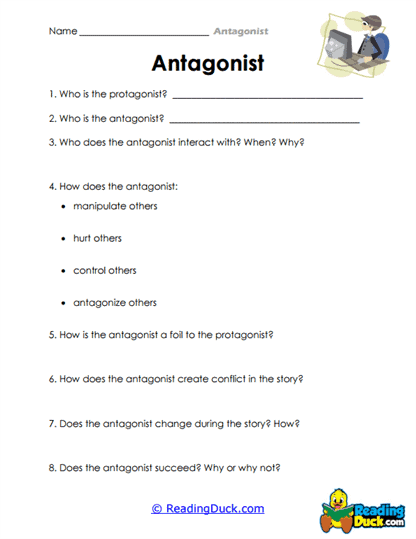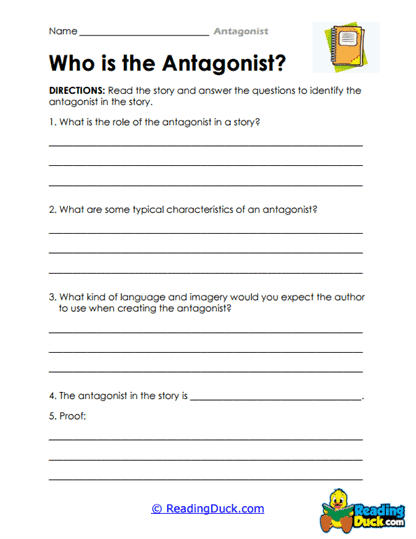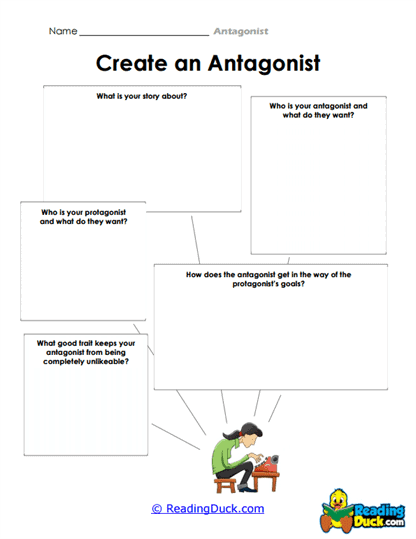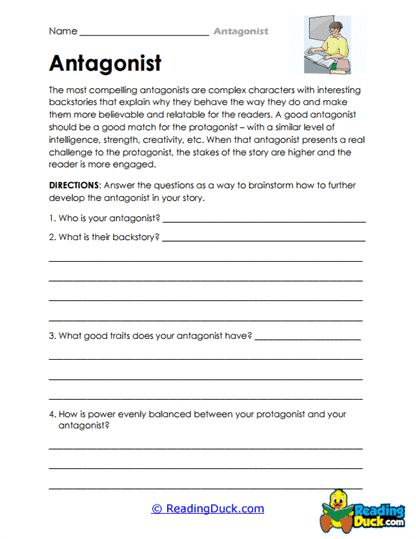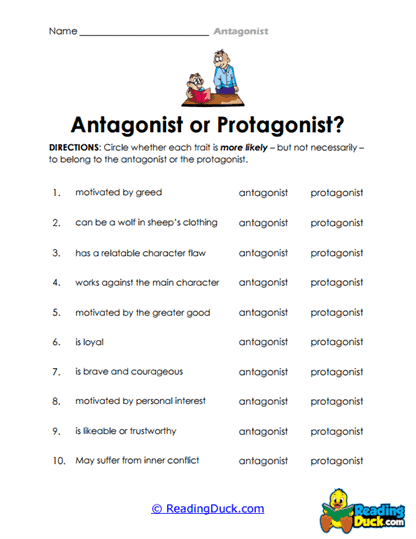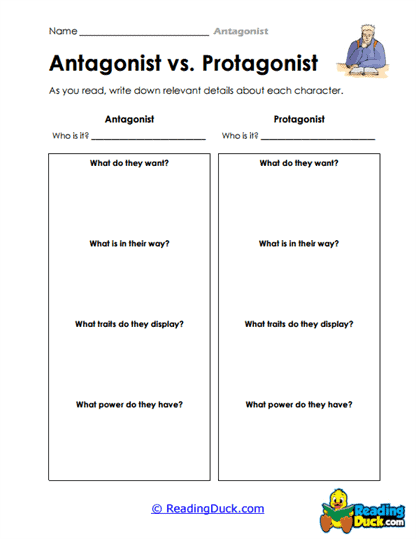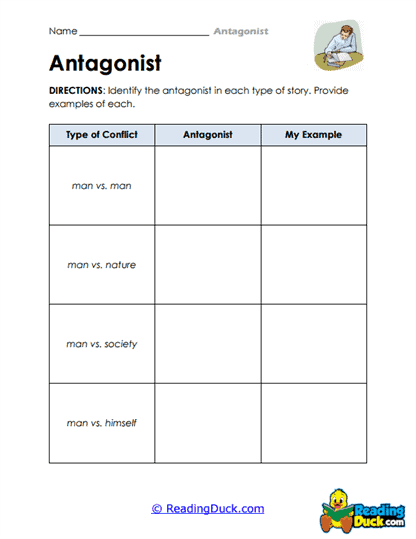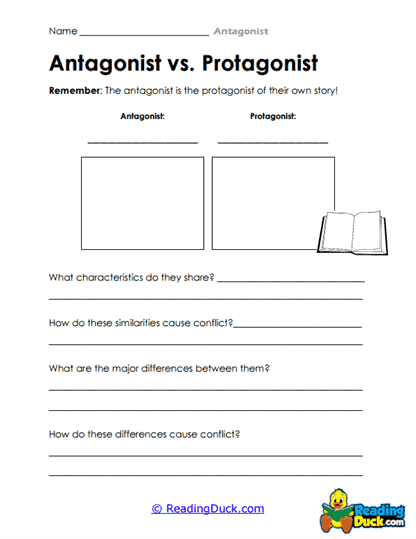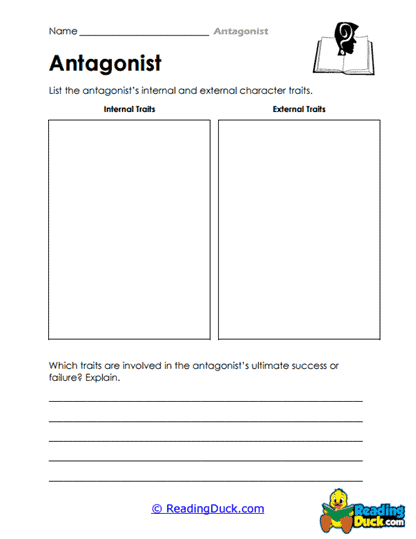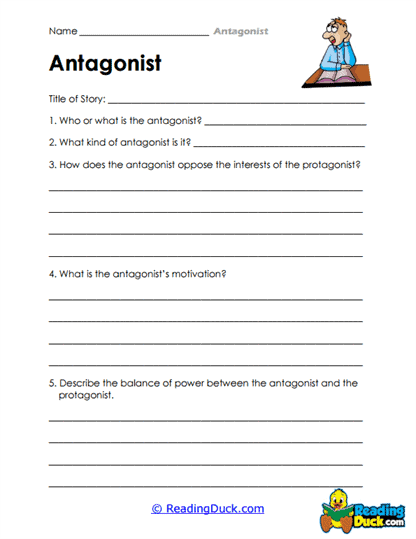Antagonists Worksheets
About Our Antagonists Worksheets
This collection of Antagonists Worksheets is a valuable resource under the Literary Devices category within the Skills section, designed to enhance students' understanding of one of the most crucial elements in storytelling—the antagonist. By exploring the nature, purpose, and impact of antagonists in literature, these worksheets guide students through the intricacies of character development and conflict, which are essential for mastering literary devices. Through a range of activities, students will learn to identify, analyze, and appreciate the role of antagonists in shaping narratives.
The worksheets are presented in PDF format, ensuring ease of access and convenience. They are simple to view, download, and print, making them suitable for both classroom use and home study. Additionally, each worksheet includes a downloadable answer key, allowing for efficient assessment and self-evaluation.
Understanding Antagonists: A Deep Dive into the Role of the Adversary in Literature
Antagonists play a pivotal role in literature, serving as the primary source of conflict and challenge for the protagonist. Without an antagonist, a story often lacks the tension and drive that keep readers engaged. Understanding what an antagonist is and how they function within a narrative is fundamental to grasping the dynamics of storytelling.
What is an Antagonist?
- Definition: An antagonist is a character, group of characters, institution, or force that opposes the protagonist, creating conflict and driving the narrative forward. The antagonist is not necessarily evil or malicious, but their goals or actions are in direct opposition to the protagonist’s objectives.
- Example: In J.K. Rowling’s Harry Potter series, Lord Voldemort serves as the primary antagonist. His quest for power and immortality directly conflicts with Harry Potter’s desire to protect his loved ones and bring peace to the wizarding world.
Types of Antagonists
- Human Antagonists: These are characters who oppose the protagonist due to conflicting goals, values, or beliefs. For example, Mr. Darcy in Jane Austen’s Pride and Prejudice initially serves as an antagonist to Elizabeth Bennet, as his pride and prejudice stand in the way of their relationship.
- Supernatural Antagonists: These antagonists are often otherworldly beings or forces, such as monsters, spirits, or gods. In Beowulf, Grendel is a supernatural antagonist whose malevolent actions bring chaos to the kingdom, necessitating Beowulf’s heroic intervention.
- Societal Antagonists: Sometimes, the antagonist is not a person but society itself. Social norms, laws, or cultural expectations can serve as antagonistic forces. For instance, in The Handmaid’s Tale by Margaret Atwood, the oppressive society of Gilead is the antagonist, imposing its will on the protagonist, Offred.
- Internal Antagonists: Occasionally, the protagonist’s own internal struggles or flaws act as the antagonist. These internal conflicts can be just as intense as external ones. In Shakespeare’s Hamlet, Hamlet’s indecision and inner turmoil serve as his own antagonist, preventing him from taking action.
- Nature as an Antagonist: In many stories, natural forces serve as the antagonist. This includes disasters, animals, or environmental conditions. Jack London’s To Build a Fire exemplifies this, where the harsh and unforgiving wilderness acts as the antagonist to the protagonist’s survival.
The Role of Antagonists as a Literary Device
Antagonists are central to the structure and function of a narrative, providing the necessary tension and obstacles that the protagonist must overcome. Their presence defines the protagonist’s journey and often highlights the central themes of a story.
Historical Context and Evolution
The concept of the antagonist has evolved alongside the development of storytelling itself. In ancient myths and epics, antagonists were often gods, monsters, or other powerful beings that represented the chaos or evil the hero needed to conquer. For instance, in Greek mythology, antagonists like the Hydra or the Minotaur posed significant challenges to heroes like Hercules and Theseus.
During the classical period, playwrights like Sophocles and Euripides refined the role of the antagonist, often portraying them as complex characters with understandable motivations, rather than merely evil figures. This nuanced portrayal allowed for more sophisticated narratives where the conflict was not simply between good and evil, but between competing values and ideals.
In modern literature, the role of the antagonist has expanded even further. Authors now explore a wide range of antagonistic forces, including psychological struggles, societal pressures, and abstract concepts like fate or time. This evolution reflects a deeper understanding of conflict and the human experience, allowing for more layered and thought-provoking stories.
Characteristics of an Effective Antagonist
- Complexity: A well-developed antagonist is more than just an obstacle; they are a fully realized character with their own goals, motivations, and backstory. This complexity makes them more relatable and, often, more frightening.
- Sympathy: Some of the most memorable antagonists evoke a degree of sympathy from the audience. By understanding the antagonist’s perspective, readers can see the conflict from multiple angles, adding depth to the narrative.
- Power: The antagonist must have the power to pose a real threat to the protagonist. Whether this power is physical, intellectual, or emotional, it should be formidable enough to challenge the protagonist effectively.
- Consistency: A strong antagonist remains true to their character throughout the story. Their actions and decisions should align with their established motivations and personality, making them a credible and consistent force within the narrative.
The Impact of Antagonists on Early Literacy Skills
Introducing young learners to the concept of antagonists can significantly enhance their literacy skills. Understanding the role of antagonists in stories helps students develop a more nuanced approach to reading and analyzing literature.
- Enhanced Comprehension: By recognizing the antagonist’s role in a story, students can better understand the narrative’s structure and the motivations of different characters. This comprehension is crucial for more advanced literary analysis and critical thinking.
- Improved Writing Skills: Learning about antagonists allows students to create more dynamic and engaging stories. When students write their own stories, understanding how to develop an antagonist helps them build conflict, tension, and resolution effectively.
- Critical Thinking and Perspective-Taking: Analyzing antagonists encourages students to think critically about different perspectives. Understanding the antagonist’s point of view fosters empathy and helps students grasp the complexity of human motivations and actions.
- Vocabulary and Expression: As students explore the characteristics and actions of antagonists, they encounter new vocabulary and ways of expressing complex ideas, which enriches their language skills and ability to articulate thoughts clearly.
Engaging Activities to Reinforce Learning
To deepen students' understanding of antagonists, educators can implement various engaging activities that complement the worksheets. These activities cater to different learning styles and grade levels, ensuring that students of all ages can benefit from a comprehensive exploration of the topic.
Suggested Activities
- Character Role-Playing (Grades 5-7): Have students choose a protagonist and an antagonist from a story they’ve read. In pairs, they can role-play a confrontation between these characters, focusing on expressing their motivations and goals. This activity helps students internalize the conflict and better understand each character's perspective.
- Antagonist Profiles (Grades 6-8): Encourage students to create detailed profiles of well-known antagonists. They should include the antagonist’s background, motivations, strengths, and weaknesses. This activity helps students practice character analysis and improve their critical thinking skills.
- Story Rewrites (Grades 7-9): Ask students to rewrite a scene from a story from the antagonist’s point of view. This exercise encourages creative thinking and deepens their understanding of the antagonist’s motivations and role in the story.
- Conflict Mapping (Grades 5-8, Homeschool and Classroom): Students can create visual maps that outline the conflict between the protagonist and antagonist. These maps can include key events, turning points, and resolutions, helping students visualize the structure of the narrative.
- Group Discussions (Grades 8-10): Facilitate group discussions where students debate whether certain characters are true antagonists or simply misunderstood. This activity promotes critical thinking and allows students to explore the complexity of character roles in literature.
The Importance of Understanding Antagonists in Academic and Personal Life
In summary, the Antagonists Worksheets are a crucial resource for developing students' literary analysis skills, enhancing their understanding of narrative structure, and fostering critical thinking. By studying antagonists, students gain insights into the mechanics of storytelling, the nature of conflict, and the motivations that drive human behavior.
Understanding antagonists is not only important for academic success but also for personal growth. As students learn to analyze and empathize with different characters, they develop a more nuanced understanding of people and situations in real life. This skill is invaluable in fostering empathy, improving communication, and resolving conflicts constructively.
Moreover, the ability to recognize and understand antagonistic forces—whether in literature, history, or personal experiences—equips students with the tools they need to navigate challenges and adversities in their own lives. Whether they are aspiring writers, critical readers, or thoughtful individuals, mastering the concept of the antagonist will serve them well in both their academic journey and personal development.
